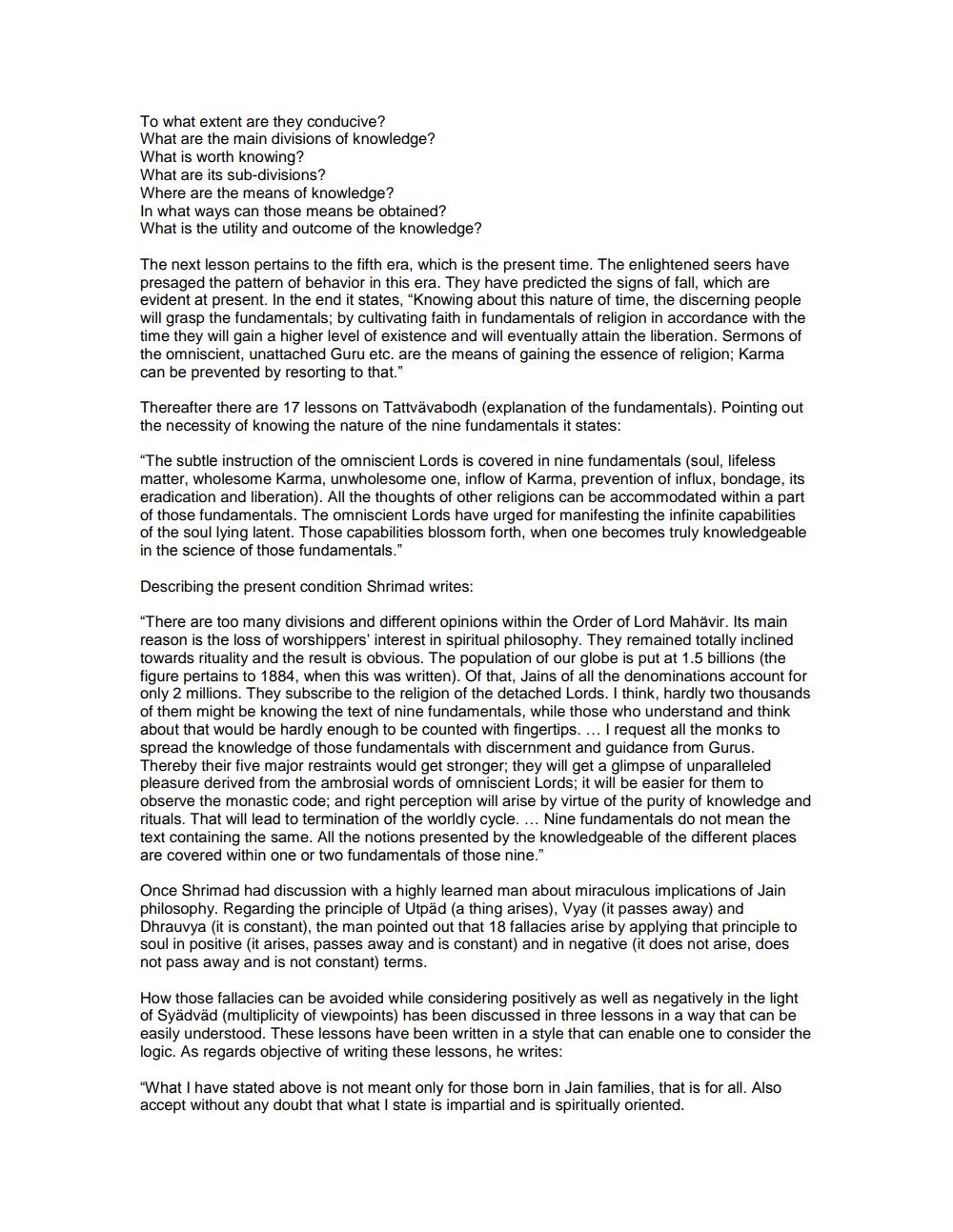________________
To what extent are they conducive? What are the main divisions of knowledge? What is worth knowing? What are its sub-divisions? Where are the means of knowledge? In what ways can those means be obtained? What is the utility and outcome of the knowledge?
The next lesson pertains to the fifth era, which is the present time. The enlightened seers have presaged the pattern of behavior in this era. They have predicted the signs of fall, which are evident at present. In the end it states, "Knowing about this nature of time, the discerning people will grasp the fundamentals; by cultivating faith in fundamentals of religion in accordance with the time they will gain a higher level of existence and will eventually attain the liberation. Sermons of the omniscient, unattached Guru etc. are the means of gaining the essence of religion; Karma can be prevented by resorting to that."
Thereafter there are 17 lessons on Tattvävabodh (explanation of the fundamentals). Pointing out the necessity of knowing the nature of the nine fundamentals it states:
"The subtle instruction of the omniscient Lords is covered in nine fundamentals (soul, lifeless matter, wholesome Karma, unwholesome one, inflow of Karma, prevention of influx, bondage, its eradication and liberation). All the thoughts of other religions can be accommodated within a part of those fundamentals. The omniscient Lords have urged for manifesting the infinite capabilities of the soul lying latent. Those capabilities blossom forth, when one becomes truly knowledgeable in the science of those fundamentals."
Describing the present condition Shrimad writes:
"There are too many divisions and different opinions within the Order of Lord Mahävir. Its main reason is the loss of worshippers' interest in spiritual philosophy. They remained totally inclined towards rituality and the result is obvious. The population of our globe is put at 1.5 billions (the figure pertains to 1884, when this was written). Of that, Jains of all the denominations account for only 2 millions. They subscribe to the religion of the detached Lords. I think, hardly two thousands of them might be knowing the text of nine fundamentals, while those who understand and think about that would be hardly enough to be counted with fingertips. ... I request all the monks to spread the knowledge of those fundamentals with discernment and guidance from Gurus. Thereby their five major restraints would get stronger; they will get a glimpse of unparalleled pleasure derived from the ambrosial words of omniscient Lords, it will be easier for them to observe the monastic code; and right perception will arise by virtue of the purity of knowledge and rituals. That will lead to termination of the worldly cycle. ... Nine fundamentals do not mean the text containing the same. All the notions presented by the knowledgeable of the different places are covered within one or two fundamentals of those nine."
Once Shrimad had discussion with a highly learned man about miraculous implications of Jain philosophy. Regarding the principle of Utpäd (a thing arises), Vyay (it passes away) and Dhrauvya (it is constant), the man pointed out that 18 fallacies arise by applying that principle to soul in positive (it arises, passes away and is constant) and in negative (it does not arise, does not pass away and is not constant) terms.
How those fallacies can be avoided while considering positively as well as negatively in the light of Syädväd multiplicity of viewpoints) has been discussed in three lessons in a way that can be easily understood. These lessons have been written in a style that can enable one to consider the logic. As regards objective of writing these lessons, he writes:
"What I have stated above is not meant only for those born in Jain families, that is for all. Also accept without any doubt that what I state is impartial and is spiritually oriented.




